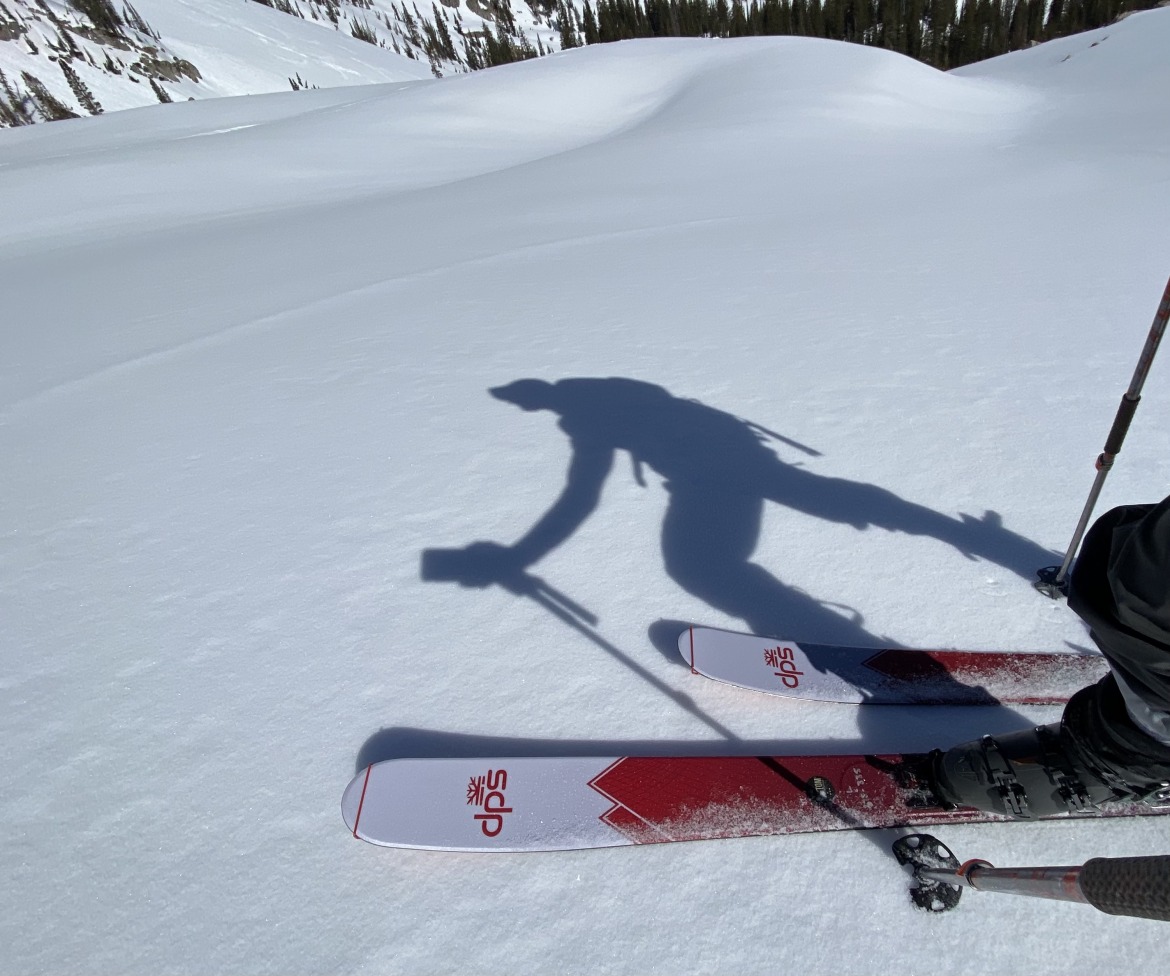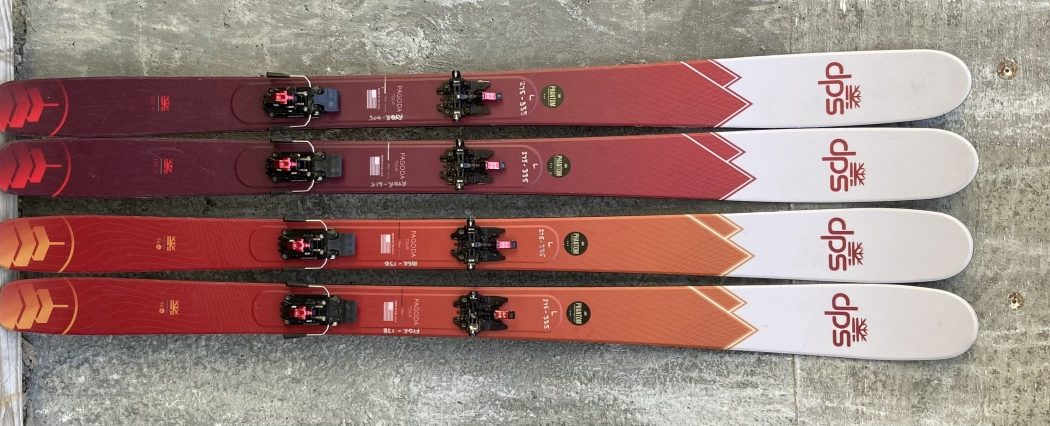
The DPS Pagoda Tour 100 RP (top) and the Pagoda Tour 94 C2: two skis from the SLC ski maker with slightly different personalities.
This late winter and into summer I set out to test the DPS 100 RP (179cm) vs the DPS 94 C2 (178cm). For those wishing to squander their time elsewhere, let me offer a brief synopsis up front. The DPS 100 RP is an outstanding all around ski. It will more than satisfy a large number of skiers in an extremely wide range of conditions, especially trending toward softer snow. The DPS 94 C2 is also an outstanding all around ski that will likewise satisfy most skiers in a wide range of conditions especially trending toward harder snow. The surprising thing is how far in each direction both skis are excellent. They overlap as a great choice over a large range of conditions and only really stand apart from each other at the extremes. To pick one or the other, the choice would rely on your typical touring conditions and your skiing style. For more detail read on.
Spring brought the most wintery weather we had for months here in the Wasatch. The first day out on the DPS 100 RP was spring storm skiing: 12-18” of fresh over everything from a hard crust to sharp rocks. Anticipating the comment section let me point out that DPS is not paying me, not paying WildSnow.
The DPS 100 RP Basics:
— ~45% rocker
— ~55% effective edge
— Dimensions (179cm): 132/100/117
— Turn radius 15m
– Weight in test length 179cm 1480g
The DPS 94 C2 Basics:
— ~25-35% rocker
— ~70% effective edge
— Dimensions (178cm): 131/94/110
– Turn radius 19m
— Weight in test length 178cm 1430g
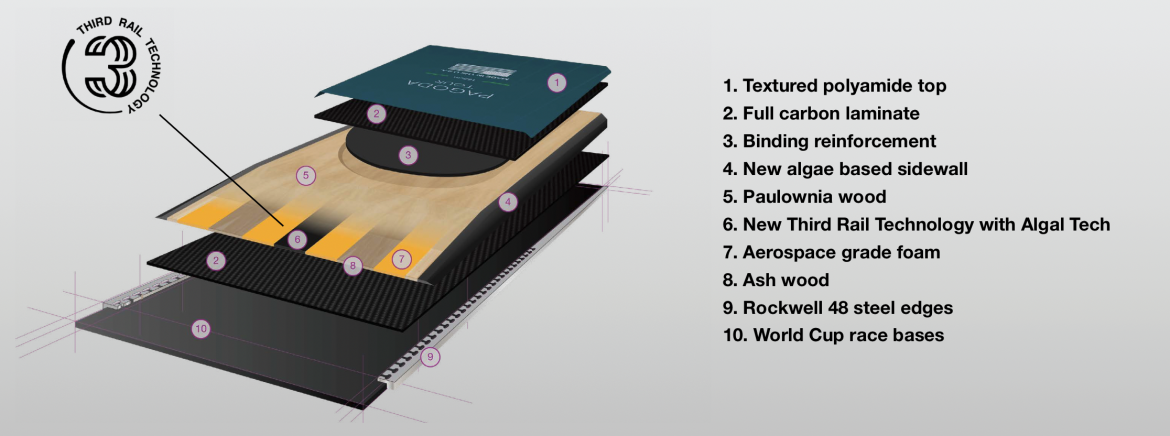
The Pagoda Tour line of skis offers up foam, carbon, algae based sidewalls, ash, Paulownia and some DPS magic.
Heading out on day one, my partners, both old-time Wasatch kooks (kooks in the best sense), had around 110 underfoot. I was on the 100’s and thinking it was going to be a challenge in the fresh and deep. I’d never been on these or any DPS ski before.
In the tradition of Tom Sawyer, the kooks granted me the privilege of breaking trail up a zone that they both agreed always held the deepest snow in the Wasatch…you know, for the integrity of the test. The tips rose to the occasion. The shape of the tips and the more rearward mount made trailbreaking easy, and indeed the snow was very deep. Kick turns were as easy as any ski I’ve used and easier than most, granted I have hitherto typically skied wider skis. I spent the majority of the early season, which did have some great snow, on Volkl V-Werks Katanas which are a nimble 112 under-foot and I still break out the Moment Bibby Pro Tours on occasion, which are 116 underfoot and this year I’ve also spent a lot of time on the 4FRNT Raven at 104 underfoot. I rarely take out my narrow Atomic Backlands, but I am familiar with a narrower ski too.
Skinning conditions were easy going until the steeps near the ridgelines where the wind had left challenging ribbons of slick crust and easily sloughing snow. The 100 RPs felt well balanced and light on the feet, and had enough skin on the snow to offer plenty of traction. At the ridgelines I had little problem holding an edge on the crust and reached the ridge with what I deemed no more difficulty than my partners.
The 100 RP has an effective edge that is 55% of the total edge. Compared to the 94 C2, at around 70% effective edge. On paper this is not a lot of edge-on-snow contact. But it is really only in comparison to the 94 C2 that I give this more than a passing thought. I felt totally comfortable gaining the ridge in conditions where the C2 would be more at home and, in fact, the C2 was at home, so we’ll find out about that later.
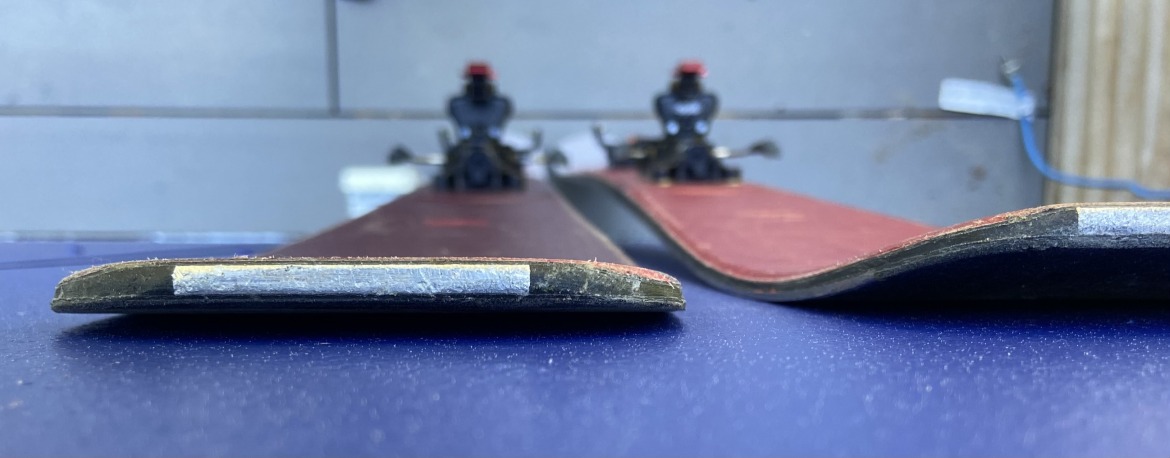
The Pagoda Tour 100 RP (left) has a shorter effective edge than the 94 C2. Yes, the 100 RP also has a flatter tail.
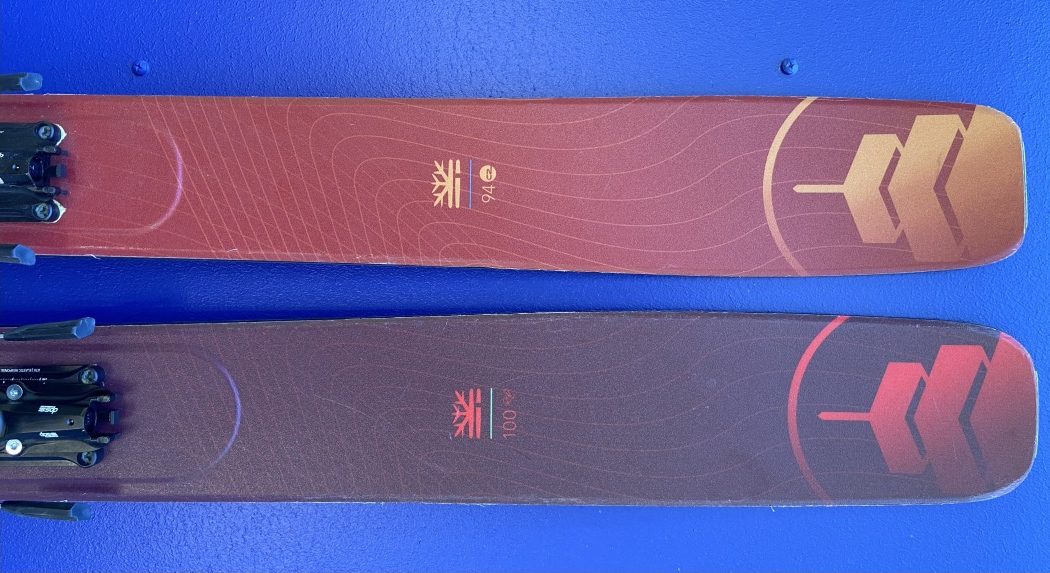
The tail geometry of the two skis, the 94 CS (top) and 100 RP bottom differ as well. The 100 RP has a tapered tip and tail, and corresponding shorter effective edge.
I enjoy going uphill. I have a long and slightly concerning history with huffing and puffing and trying hard. But we are now at the good part. In my mind this is the part of the review that counts, which reveals a bit about me and what I think matters most in a ski. A ski that really rips on the downhill gets some leeway on its uphill performance. I have suffered up some horrid skinners, sweating and cursing on 190cm 116 underfoot skis just to taste that unstoppable speed, stability and yeehaw fun of the Moment Bibby Pros. I am trying to tell you that though I like going uphill, and to stay out as long as time permits, I want a ski that inspires a creative take on the slope beneath me. This requires a ski oozing confidence, and that, for me, has meant something wider, longer, heavier and typically of a more modern rather than traditional build. This has equated to a ski that some will not accept for uphilling. The Bibby Pro Tours are around 1900g. The Katana V-Werks are 184cm, 112 underfoot and 1880g. The Katana is a fully rockered ski that rips and really deserves its own review. And here we are at the good part with a 1480g, scrawny ass 100 underfoot and having hardly broken a sweat on the uphill.
It turns out I had nothing to worry about.
Finding Clarity with the 100 RP
Let me jump forward a few weeks to what I am calling one of the top five ski days of my life. We received 20-30” on top of a bomber base and it was still snowing. Conditions were deep, soft and relatively safe. I was on the DPS 100 RP because by this time, I knew when I was standing on top of the line, I was on a ski that would rip, carve, wiggle, slide, slash, float, offer stability and playfulness providing confident, creative, full-on yeehaw experience.
Like I said, top five, all time. I am no longer concerned about the width of this ski. Even for very deep days. I will address some potential caveats to that later.
Ever since that first day with the kooks I have been undergoing a sort of internal crisis. I don’t really want to love this ski as much as I do. Besides float, I like the solid stability of a wider ski. I have, in the past, gone too far with some comments about narrow skis. And now I have to eat crow. Given the 100 RP’s deep snow performance I am not sure you need another ski let alone a fatter one. Gulp. I said it. Besides the mea culpa, I regret saying it mostly because I want to have more than one pair of skis. I love skis, I want a quiver of awesome, amazing fat ones, skinny ones, cool ones, business skis and party skis. But what if this is the only ski I reach for?
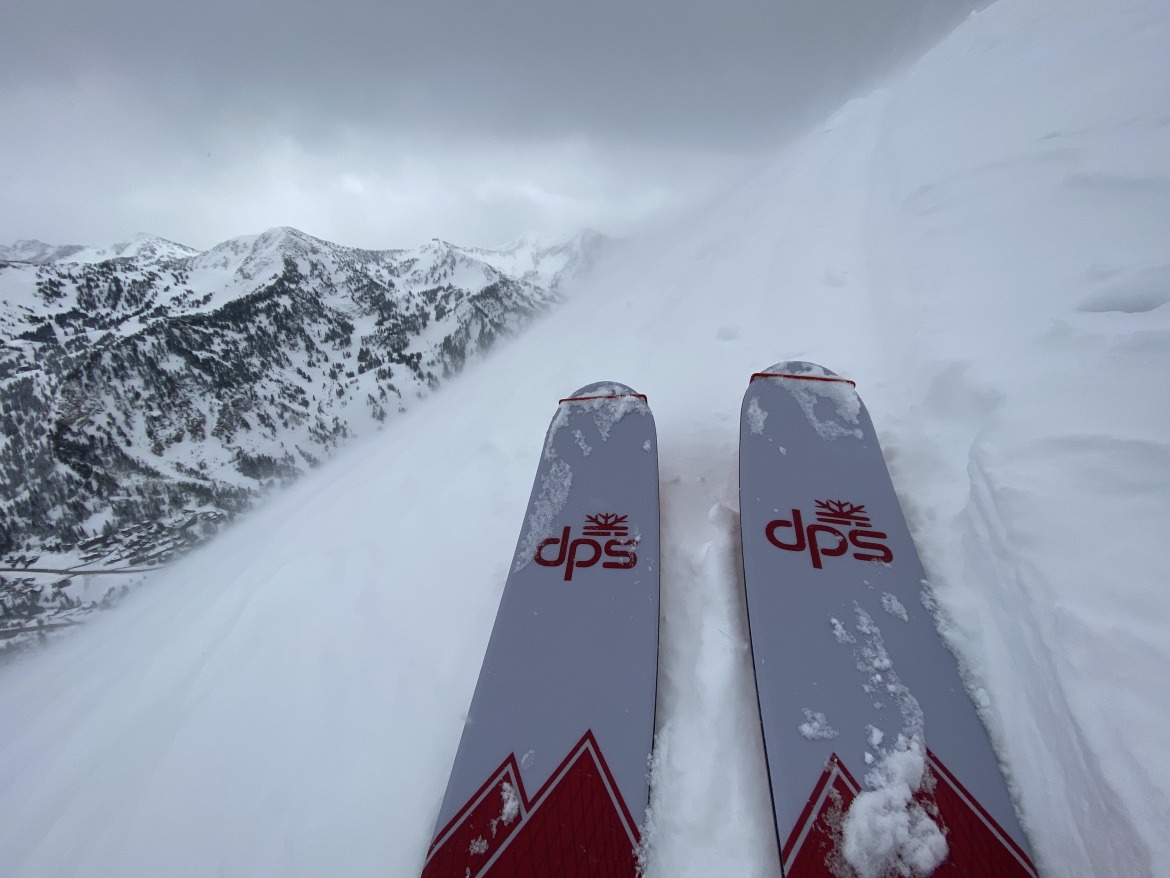
Given the 100 RP’s deep snow performance I am not sure you need another ski let alone a fatter one. Gulp. I said it.
Most of the winter I’ve been skiing on the 4FRNT Raven. The Raven was my attempt at a skinny, light, super maneuverable and still versatile ski. And it is. It is 104 underfoot, 177cm, 1720g and full rocker. While most of the mid winter was, well you know, shitty, I had a lot of great days on the Raven. Even in less than ideal conditions I had a great time hunting powder-like snow that resides in those hidden spots long after the last storm. They are a super maneuverable ski, they can also go fast, do float well but in powder I’d say they have this incredible way of slicing through deep, light snow, so you are riding through it rather than on it. If this was a Raven review I’d say the only downside is that they’re slightly less secure skinning on hard, slick surfaces and similarly are less secure descending super hard surfaces, but that in both cases not to a degree that turned me off because in soft snow they are truly a blast. I was not super stoked on the Raven jump turning down some hard crust in tight trees. There was just a little too much fore-aft play, the same play that made them incredibly fun shushing through some thick, heavy “powder” in similarly tight terrain. I am totally confident that many skiers would love the Raven in a wide variety of soft to fairly deep conditions. They are great skis. But now I’m in a quandary. The 100 RP is more secure on a slick skin track and descending harder snow and they slay powder too. What is a ski hoarder to do?
In spring, powder days don’t last long. I got out on both the DPS 94 C2 and 100 RP in some transformed powder and slush on crust. I was surprised in these conditions by how similar the skis felt. I expected the C2 to really stand out, granted the conditions were still quite soft on the surface and edgeable beneath. They both can carve fairly tight turns, and arc big ones at higher speed. The C2 has a 19m turn radius, which I consider very tight. The Raven has a 29m turn radius, the Katana is 23.5m, granted both are reverse camber skis and the Bibby’s are 27m. The RP is even tighter at 15m. A tight radius can sometimes hook up in unwanted ways, but I haven’t experienced that at all. I could say that 100 RP was slightly easier to pivot and wiggle in tight spots, and even compared to the C2 the edge hold was very good. The difference between the two was minimal. The shorter turn radius of the RP did not seem to compromise its ability to go fast, and did make it easier to carve a bit tighter. But again the difference between the two was not huge.
Wasangles can get tracked out. In certain zones, and especially as you near the trail heads, the Wasatch can be exactly like inbounds skiing. While these are not ultra-light skis they are not resort weight skis either. They strike a good balance. I wasn’t being tossed all over like some lighter skis I’ve been on, nor are they bomb proof like some heavier skis I’ve been on, but they do pretty damn well even compared to the heavier Katana and certainly compared to the Raven, and the Raven is much less prone to getting knocked around than the older Atomic Backlands I have typically used for spring and summer skiing. The DPS combo is not letting me down yet.
Two days after the storm, it is spring and the sun is high. As I ascended the skin track I could see a poor soul descending a south facing slope across the way. They were traversing with obvious effort, performing a hectic jump turn and traversing back. And only two days ago this was all face shots, and woohoo. Mental note: avoid anything south facing, or try to. I was out on the 94 C2 and hunting powder hiding on the north and east aspects. My first turn on the C2 was in 5” of soft over a firm edgeable base. This was the softest, deepest snow I’d had these out in, yet immediately I was confident I could open it up.
As I got off the ridge the snow got deeper and softer and even though there is less rocker than the RP’s the tips stayed up easily in the 5” of light snow. My line took me off the north face over a sub-ridge onto the east face which had warmed in the morning sun. The snow, which felt fairly light and cold as I prodded it on the way up, was much thicker now, and much deeper off the ridge. Here, I am missing that shovel shape and extra rocker of the RP. If this was just a 94 C2 review, I’d say, hell yes, these are solid in hot pow, but the RP would be even better. By the bottom, the surrounding faces are littered with rollerballs, a few the size of truck tires and so I hurriedly skinned up and scurried over onto more northerly aspects.
While skinning the sun-slicked skin track I wondered what has more traction, the RP, rockered but wider or the narrower C2 with less rocker? I think it should be the C2, but I’m not so sure. It is slick skinning but the C2 handled it just fine. I stick to more northerly terrain and even in 12” of soft powder hidden in steep trees the C2 is great. I’m surprised by how well it floats and enables both longer sweeping turns and some wiggles between tight trees. I’m confident enough to send it off a cornice and get a little forward on the landing, momentarily I think, oh shit I’m going over the bars, but the tips support my error and the skis plane up and I’m shushing turns with abandon and joy. I think the RP would have been a better choice for this snow, but the C2, besides supporting my poor landing with aplomb, is surprisingly agile, quick when it needs to be and stable with more speed. It made me wonder if the 106 C2 might check some of the soft snow boxes the 94 C2 doesn’t and still be a great hard snow and variable snow choice. Perhaps the next test is 100 RP vs 106 C2. Then again, if the 100 RP is this good in powder, how good would the 112 be?
On what had become a wasatch luge track back down to the car the C2 is carvable, easy to swivel, shut down speed and in fact I’m having a fun time looking for little lips to jump and side staches to whip into. I’m pretty sure the 112 RP wouldn’t be this fun here. But what about that 106 C2? So many skis to try!
And then I got to the breakable crust. I mean, who loves breakable crust besides on creme brulee? I approached it with a bit of confidence and realized with no little concern that I was locked in and turning was going to be a bitch. I was skiing rather like the poor soul I saw earlier and while I wondered if the RP would have planed up a bit better than the stiffer tips of the C2, it’s likely that nothing would have turned it into type 1 fun, or any kind of fun at all.
Fortune shone on me and I had more opportunities to test both skis in breakable crust. Now, there is breakable crust and there is unpredictable breakable crust, crust that supports you and then doesn’t with a slight change of aspect. This is sort of terrifying if you have concerns about ACLs and things like that. On predictably breakable crust I found the RP, with a bit of speed, to plane up and allow for some damn fun turns in less than great conditions. I had less success with this on the 94 C2. But in spring, conditions change by the minute let alone the day, and so I really wanted a more direct comparison.
We got a dust of pow over a softening base – beautiful, fun conditions. I dedicated this morning to hike a short run that started with a wide slope which rolled over into a steep rocky stretch navigated with a few jump turns before opening into a wide apron that started steep and mellowed. Doing this I was able to one-two the two DPS skis. While the C2 began to really stand out the RP was still a great ski. The RP was so easy to go from long sweeping turns into a few quick pivots to kill speed before dropping over the edge, jumping left, right, left, right and then opening it back up for some super fun turns down to the other pair of waiting skis. Then I’d hike the C2’s up and do it again. The C2 was a little harder to slow down before dropping over the edge, but those hop turns were so solid I was never in doubt I’d stick the turn and be ready for the next one, and then, on what was a harder bed surface with some softer snow to push around I preferred the C2’s secure carve and, when knocking into a few buried rollerballs appreciated the stiffer tip which didn’t deflect as much as the RP.
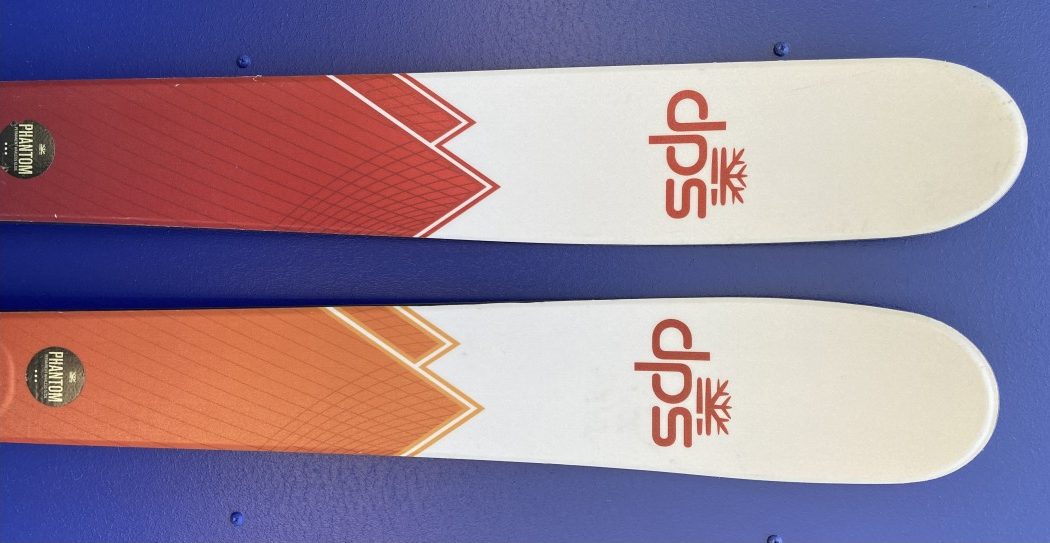
The C2 tip (bottom) is soft enough for float but stiff enough for good edge hold and doesn’t deflect off ruts and mank. In contrast the RP’s tip (top) can fold up a bit when flying into chunder at speed.
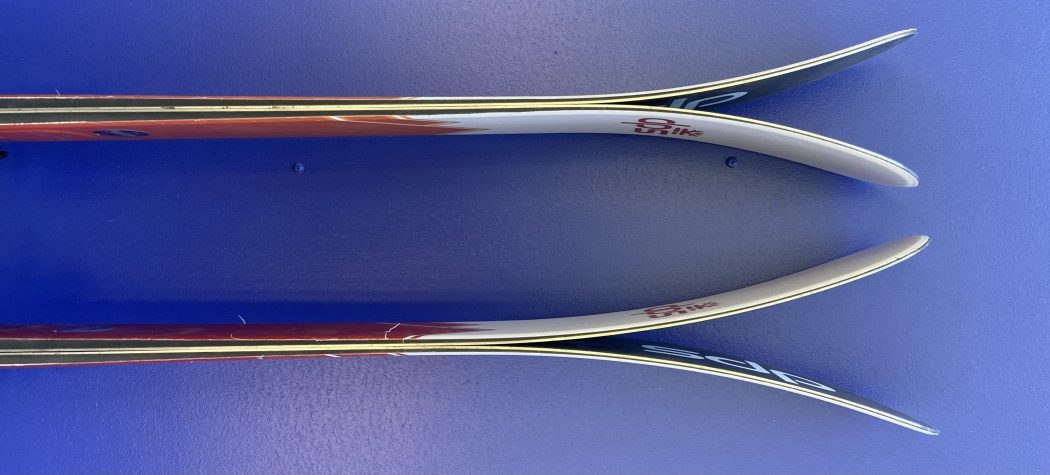
By this point, we’re hoping the skis are easier to identify. Times up: the 94 C2 is up top and the 100 RP below.
The C2 tip is soft enough for float but stiff enough for good edge hold and doesn’t deflect off ruts and mank. In contrast the RP’s tip can fold up a bit when flying into chunder at speed. This is a comment I make almost in passing, but it could be a significant detail. There are some beautiful movies by DPS Cinematic. These cats are primarily skiing the stiffer and heavier DPS skis. So one question you might ask yourself, Dash Longe might need a stiffer, heavier ski, but do you?
The answer could be yes.
Read up on last season’s review: A DPS Quiver of Two. And for more info on how DPS skis are made, read up here.
Picking a Pagoda Tour
I am 5’9 and 160lbs. I’m not an ex-alpine racer. Yet, even I enjoy the stability of the Moment Bibby Pro (now called the Wildcat Tour). And so I can definitely see someone wanting to go for a stiffer, heavier ski. And I can definitely see someone wanting to go for a wider ski as well. While I have been very happily surprised by how good the 100 RP is at speed and in the deep given its waist and weight, there are limits to what a ski can comfortably do. This site seems to trend toward folks talking about grams, and while the 100 RP balances weight and performance very, very well, you should consider where you want to taste the limits of your ski. Do you need a stiffer ski? Do you need a wider ski? Do you need a heavier ski? The answer could be yes, but I have been impressed by how fun and functional these two DPS skis are on the ups and the downs in a wide variety of conditions, terrain and speeds.
Having waited all winter for winter to start, it fortunately took a while for true spring conditions to arrive. It is not surprising that when spring was more like winter the RP would be my choice, and as spring became more like summer, the 94 became the better choice. The surprising thing is how far in each direction both skis are excellent. They overlap as a great choice over a large range of conditions and only really stand out at the extremes. If one were to pick one or the other, the choice would rely on either your typical touring conditions and/or skiing style. Not only do I tend toward a more modern shape, but the wasatch tends toward softer conditions, and so for me, if I were to choose one over the other it would be the 100 RP. But I can easily see the other side of it, in harder conditions and in places where deep snow is less the norm, the C2 would be a consistently excellent choice. Here in the Wasatch, and other areas blessed with deep days, the C2 would be a great companion to a soft snow ski.
It was a low tide winter and this left some rocks just under the surface when it did start snowing. In this review period I rammed these skis over rocks in a pretty not cool way. These are expensive skis. That is an important factor when considering your purchase. I have to say, these skis stood up very well to some pretty significant beatings. At the same time either of the skis I tested could be a versatile one ski quiver, and I suspect that would be the case for the 106 C2 as well. They cost a lot, but they could save you money too if because of their versatility you buy fewer pairs of skis to fulfill your needs. Over the past several months I have truly had a blast on these skis and I think that would be the case for a lot of other skiers too.
Here’s the last word or two. If you’ve been in the ski market for a bit of time, you know DPS skis don’t come cheap. They are made in SLC and have helped the industry adopt more progressive shapes and NASA inspired materials. Both skis reviewed will retail next season for $1,549. DPS begins their annual Dreamtime sale on Monday — if you like snazzy top sheets, click the link.
Shop for the DPS Pagoda Tour 100 RP.
Shop for the Pagoda Tour 94 C2.
Whatever you’re riding, happy skiing to you all!
Pete Vordenberg is a father of two and husband to just one making him a pretty big disappointment in Utah. He works for HC4YF.org, which works with children and families from Salt Lake City’s West Side. He also works with Citizens Climate Lobby on climate activism and The Utah Nordic Alliance on kids xc skiing. He is a filmmaker, photographer, and writer. Pete is a two time Olympian, two-time Olympic coach, former head coach of the US XC Ski Team and an avid gnome.

